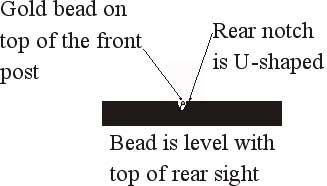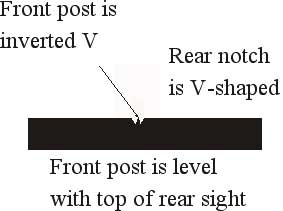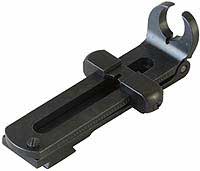by B.B. Pelletier
We are discussing the types of open sights encountered on sporting airguns and firearms.
Post and bead
This has been a popular sporting sight for more than a century. The front sight is a blade with a small bead on top. The rear sight is a u-shaped notch. On some guns, a v-shape is possible, but that means whoever selected the rear sight was not familiar with this type.

The bead on top of a post has been a popular sporting front sight for a long time – and still is today. The bead represents where the bullet will go.
I have never cared for this sight. I find it too arbitrary for accuracy beyond simple plinking, and I find that the bead is almost never lighted well enough to use it the way it was intended. The recent addition of fiber optics has made an improvement to the second shortcoming, but the sight is still too imprecise for me. On the other hand, it is found on more guns than any other sight.
Barleycorn
Another very popular sight that preceded the post and bead. This is a v-shaped front sight with an inverted “v” rear notch. It is even seen on military rifles, including the venerated M98 Mauser.

The barleycorn is very popular for both military and sporting rifles.
Post and notch
I don’t know when the post-and-notch sight was first invented, but the first use seems to be in the latter two decades of the 19th century. By that time, the blade and notch had evolved into an adjustable sight that was quite precise, and the square post was probably only seen as a good sight to use on round bullseyes. In fact, it was just one of many sight types that emerged as the first true need for long-range shooting emerged during the buffalo hunting days. When that brief period was over, long-range shooting at targets took its place, and the square front post insert in a globe front sight (with aperture rear) was popular. But, the use of a square front post with a square rear notch must date from sometime in the 20th century.

The post and notch is a target-type sight.
Then there was the buckhorn and semi-buckhorn rear sight of the 1950s and 60s. For some reason, gun companies fell in love with this type of sight. It’s really just a variation of the post and bead or barleycorn, but the “horns” were supposed to bring the eye into quicker alignment with the front sight. It’s really just stylistic and not a different type of sight.

Buckhorn sight is just a style, not a different sight. It can be either post and bead or barleycorn.
Dear B.B.
Trying to choose between Benjamin 392 and Silver Streak CB9. Which would you advise for open or peep sights? Used for target, small varmints and possibly crows.
Thank you for all your blogs.
Bill D.
Bill D.
I use my open-sighted Blue Streak more often than my peep-sighted Silver Streak, but that’s just because I like that rifle. The peep comes off when you don’t want it.
B.B.
Dear B.B.,
I am poised to purchase a pistol pellet gun and have reduced my choices to the following:
2300S crosman,subject to your test.
HW LP and
Beeman P1
The Beeman and HW LP seem to be the same gun but the R1 is more expensive because of the stocks are walnut.
Would you give me your opinion on these three pistols to help me in my purchase of one of these guns. I am going to use the purchase as a plinker and varmit gun. I think I would prefer a 22cal but this is not avalible in the P1 or crossman per pyramids information. I would appreciate your suggestion regardling .177 and .22 and the three guns mentioned. I have a R1 rifle which I have been very pleased. I shall defer purchase till you test the 2300S.
Thank you very much for your help and the information you present on your blog.Oh Yes! Ignore price as a consideration, just quality and performance.
Earl
Earl,
For hunting you want power, ands a .22 with 6 foot-pounds is pretty light. It will work with excellent shot placement, but there isn’t much room for error.
I will be receiving the 2300S soon, so you won’t have long to wait.
B.B.
B.B.
My real question is, would you recommend a silver streak over a 392, or the other way around? Probably would still use open sights.
Bill D.